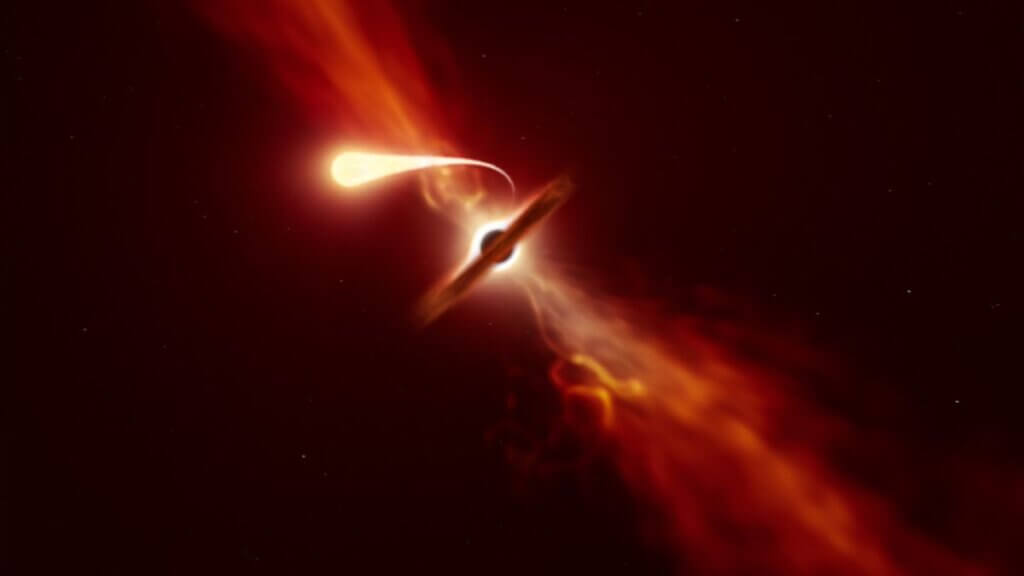One of the brightest transient events is the result of a supermassive black hole beginning to feast on surrounding matter resulting in one of the most dramatic “switching on” events ever seen.
Transients are astronomical events or objects that change in brightness over short periods of time, and the one powered by this greedy black hole — J221951 — is one of the brightest transients ever recorded. The position of the black hole corresponds with the center of a previously observed galaxy, just where a supermassive black hole would be expected to sit. However, astronomers still aren’t sure exactly what is causing the transient event witnessed in J221951 .
“Our understanding of the different things that supermassive black holes can do has greatly expanded in recent years, with discoveries of stars being torn apart and accreting black holes with hugely variable luminosities,” team member and University of Belfast astronomer Matt Nicholl, said in a statement. “J221951 is one of the most extreme examples yet of a black hole taking us by surprise.”
Related: Star survives spaghettification by black hole
The nature of what the supermassive black hole located around 10 billion light-years away is consuming is currently unknown, but it is possible that J221951 represents a star that has ventured too close to the black hole being violently ripped apart by tidal forces arising from its immense gravity in a process called spaghettification.
This occurrence, called a tidal disruption event (TDE), would see some of the stellar material from the destroyed star fall to the surface of the black hole while other matter is funneled to the poles of the black hole before being blasted out at near light-speeds, generating intense electromagnetic radiation.
The spaghettification of an unfortunate star isn’t the only possible mechanism that could be causing the black hole in question to give rise to this bright transient event, however. Another possibility is that J221951 is the result of the nucleus at the heart of a galaxy switching from a dormant to an active state.
Active galactic nuclei (AGNs) are bright areas at the heart of galaxies that blast out enough light to drown out the combined light of every star in the rest of that galaxy. They are also powered by supermassive black holes.
“Continued monitoring of J221951 to work out the total energy release might allow us to work out whether this is a tidal disruption of a star by a fast-spinning black hole or a new kind of AGN switch on,” Nicholl added.
Watching the dramatic “switching on” at the heart of a galaxy
Kilonovas are a type of transient event that occurs during the merger of two neutron stars or a neutron star and a black hole, which releases bright bursts of electromagnetic radiation. Kilonovas initially have a blue coloration, then fade to red over a period of several days. The transient J221951 also appeared blue, but it didn’t change to red or fade rapidly as a kilonova would. The nature of this transient was determined by follow-ups with space-based facilities like the Hubble Space Telescope and ground-based observatories like the Very Large Telescope (VLT) located in the Atacama Desert of Northern Chile.
“The key discovery was when the ultraviolet (UV) spectrum from Hubble ruled out a galactic origin. This shows how important it is to maintain a space-based UV spectrograph capability for the future,” team member and Mullard Space Science Laboratory at University College London researcher Paul Kuin said.
With a source located 10 billion light-years away, the team realized that J221951 must be one of the brightest events ever seen. They will now work to better understand its cause.
“In the future, we will be able to obtain important clues that help distinguish between the tidal disruption event and active galactic nuclei scenarios,” Oates said. “For instance, if J221951 is associated with an AGN turning on, we may expect it to stop fading and to increase again in brightness, while if J221951 is a tidal disruption event, we would expect it to continue to fade.
“We will need to continue to monitor J221951 over the next few months to years to capture its late-time behavior.”
The team presented their findings on Tuesday, July 4, at the National Astronomy Meeting 2023 in Cardiff, U.K.

